Last updated on August 27th, 2025 at 12:13 pm
Table of Contents
ToggleAssignment: The growth, development, and learned behaviors that occur during the first year of infancy have a direct effect on the individual throughout a lifetime.

The growth, development, and learned behaviors that occur during the first year of infancy have a direct effect on the individual throughout a lifetime. For this assignment, research an environmental factor that poses a threat to the health or safety of infants and develop a health promotion that can be presented to caregivers.
Create a 10-12 slide PowerPoint health promotion, with speaker notes, that outlines a teaching plan. For the presentation of your PowerPoint, use Loom to create a voice over or a video. Include an additional slide for the Loom link at the beginning, and an additional slide for references at the end.
In developing your PowerPoint, take into consideration the health care literacy level of your target audience, as well as the demographic of the caregiver/patient (socioeconomic level, language, culture, and any other relevant characteristic of the caregiver) for which the presentation is tailored
Include the following in your presentation:
- Describe the selected environmental factor. Explain how the environmental factor you selected can potentially affect the health or safety of infants.
- Create a health promotion plan that can be presented to caregivers to address the environmental factor and improve the overall health and well-being of infants.
- Offer recommendations on accident prevention and safety promotion as they relate to the selected environmental factor and the health or safety of infants.
- Offer examples, interventions, and suggestions from evidence-based research. At least three scholarly resources are required. Two of the three resources must be peer-reviewed and no more than 6 years old.
- Provide readers with two community resources, a national resource, and a Web-based resource. Include a brief description and contact information for each resource.
Refer to the resource, “Creating Effective PowerPoint Presentations,” located in the Student Success Center, for additional guidance on completing this assignment in the appropriate style.
Refer to the resource, “Loom,” located in the Student Success Center, for additional guidance on recording your presentation.
While APA style is not required for the body of this assignment, solid academic writing is expected, and documentation of sources should be presented using APA formatting guidelines, which can be found in the APA Style Guide, located in the Student Success Center.
This assignment uses a rubric. Please review the rubric prior to beginning the assignment to become familiar with the expectations for successful completion.
You are required to submit this assignment to LopesWrite. Refer to the LopesWrite Technical Support articles for assistance.
Expert Answer and Explanation
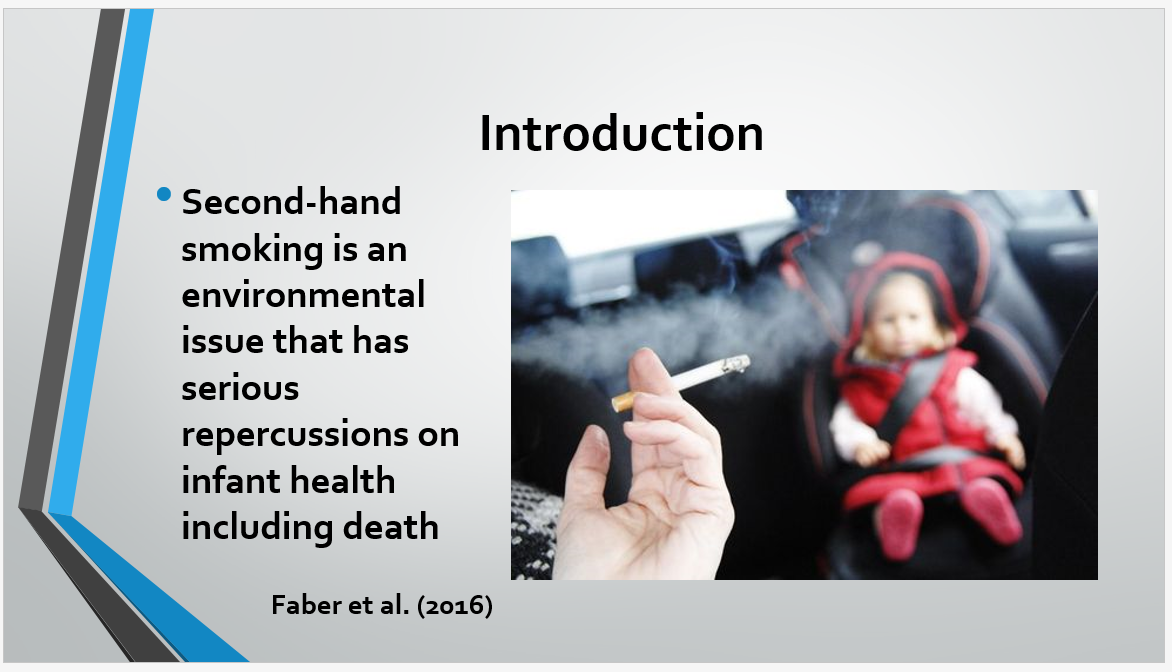
Exposing infants to second hand poses a serious negative health impacts which can lead to death of the infant. Second hand smoke can be defined as smoke exhaled by a smoker combined with smoke emitted by the burning end of the cigarette. According to Faber et al. (2016) second hand smoke is responsible for approximately 166 ,000 global child deaths.
This presentation will focus on different issues tackling the exposure of secondhand smoke on infants.
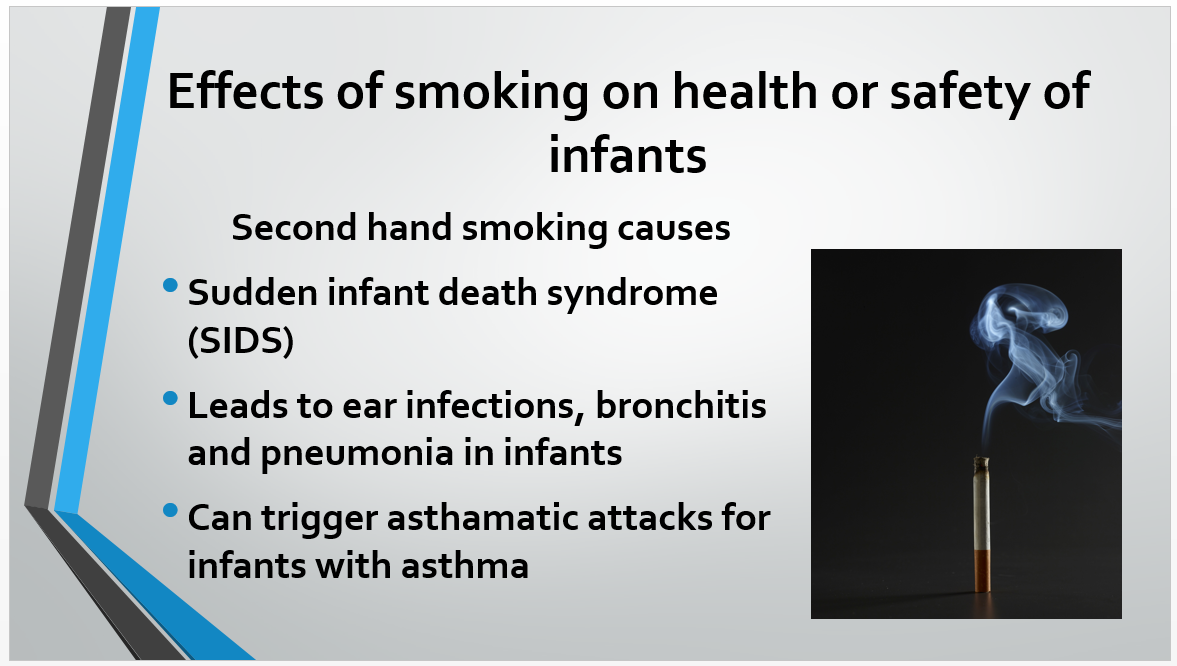
Second hand smoking has serious health repercussions on infants. Some of them include;-
Second hand smoke can lead to sudden infant death syndrome. This is a phenomenon where an infant suddenly dies without any signs of preexisting medical condition and usually occurs while sleeping (Adams, Ward & Garcia, 2015). Researchers have attributed this phenomenon to respiratory issues with second hand smoking being a contributing agent it is also reported that a number of children who died from SID had high levels of nicotine found in their lungs (Fleming, Blair & Pease, 2015).
Second hand smoke also puts children at risk of getting ear infections and other respiratory complications like bronchitis and pneumonia in infants.
Second hand smoke can also trigger asthmatic attacks in asthmatic infants (Wang et al., 2016).
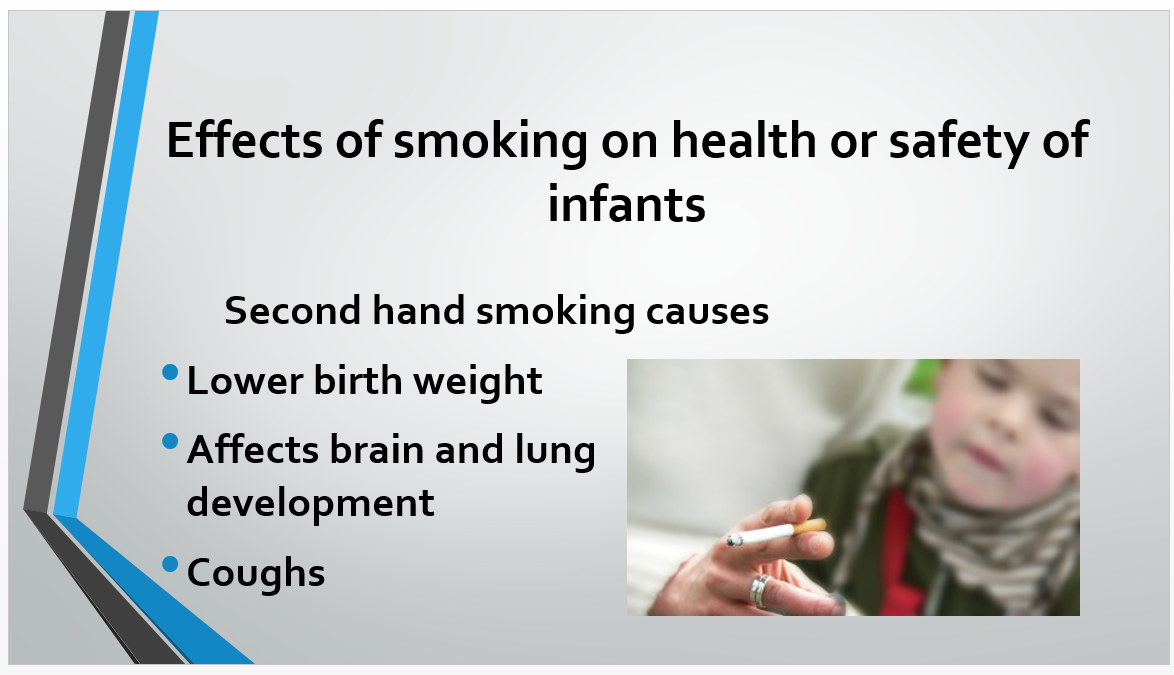
Second hand smoking is known to be one of the issues that causes lower birth weight in infants which in most cases translates to poor health status for the infant (Banderali et al., 2015)
Long term exposure of second hand smoke on infants also leads to poor brain development which may lead to learning disorders. It may also affect lung development leading to future respiratory complications.
Second hand smoke can also cause infants to develop coughs.
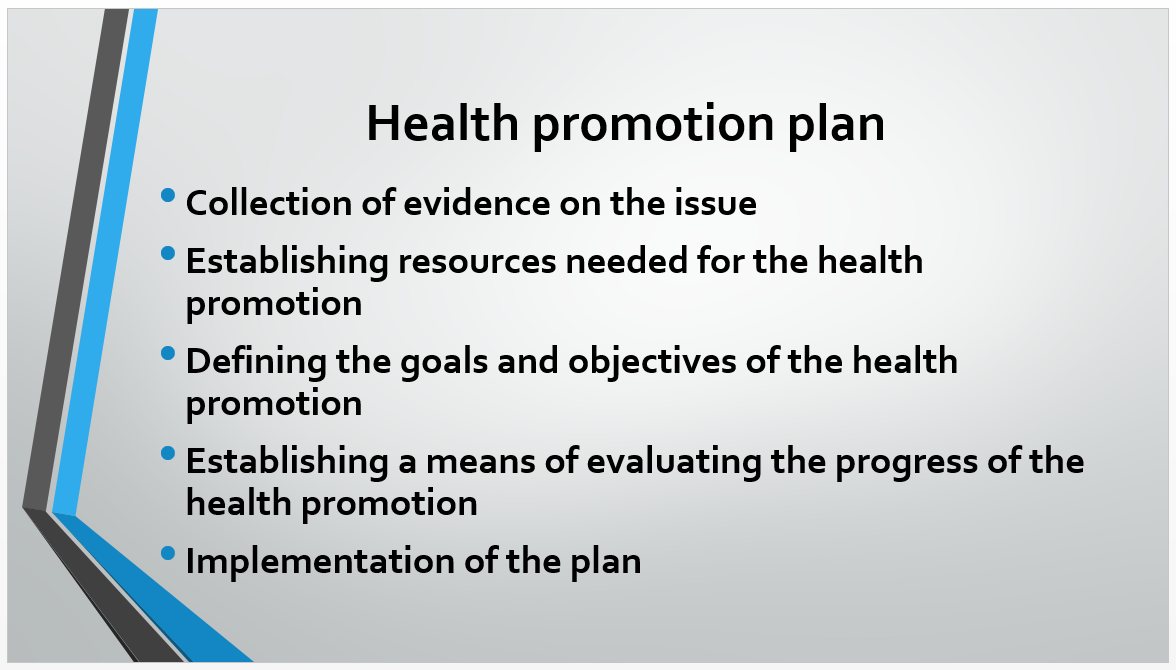
The health promotion plan which can be used by caregivers to help deal with secondhand smoke and its effects on infants will involve the following set of activities.
- Collection of evidence based information on the issue of second hand smoking and how it affects infants. This is to ensure that the health promotion is based on factual evidence with proved workable solutions that can assist in dealing with the issue.
- Establishing the required resources needed for the health promotion is also an important activity. some of the resources which will be required include learning materials, financial support, treatment facilities to aid any patient who may require help in dealing with second hand smoking, experts to articulate on the matter, to list a few.
- For any health promotion activity, it is important to have measurable goals which are going to be used to measure the success of the health promotion (Fertman & Allensworth, 2016) .
- Having a system of evaluating the progress and impact of the health promotion is another important activity of the health promotion.
- Implementing the plan after ensuring that everything is properly set up is the last part of the health promotion plan.
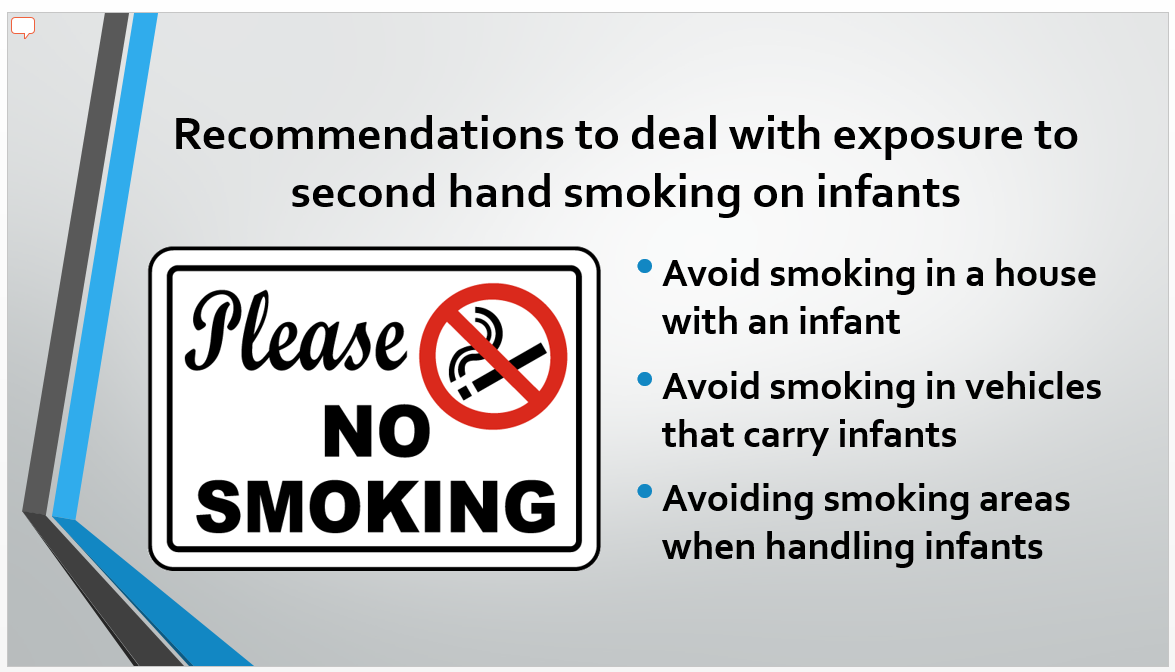
Some of the recommendations to protect infants from second hand smoke include;
- Making the house and its close environs a smoke free zone. Smoke from cigarettes takes time before it dissipates from the environment. Smoking within the house environs can put the infant at risk of being exposed to second hand smoke leading to the several detrimental health effects listed earlier.
- It is also recommended to avoid smoking in vehicles carrying infants and exposure to smoking areas. Such environments which have high concentration of second hand smoke may pose more severe health consequences on the infant.
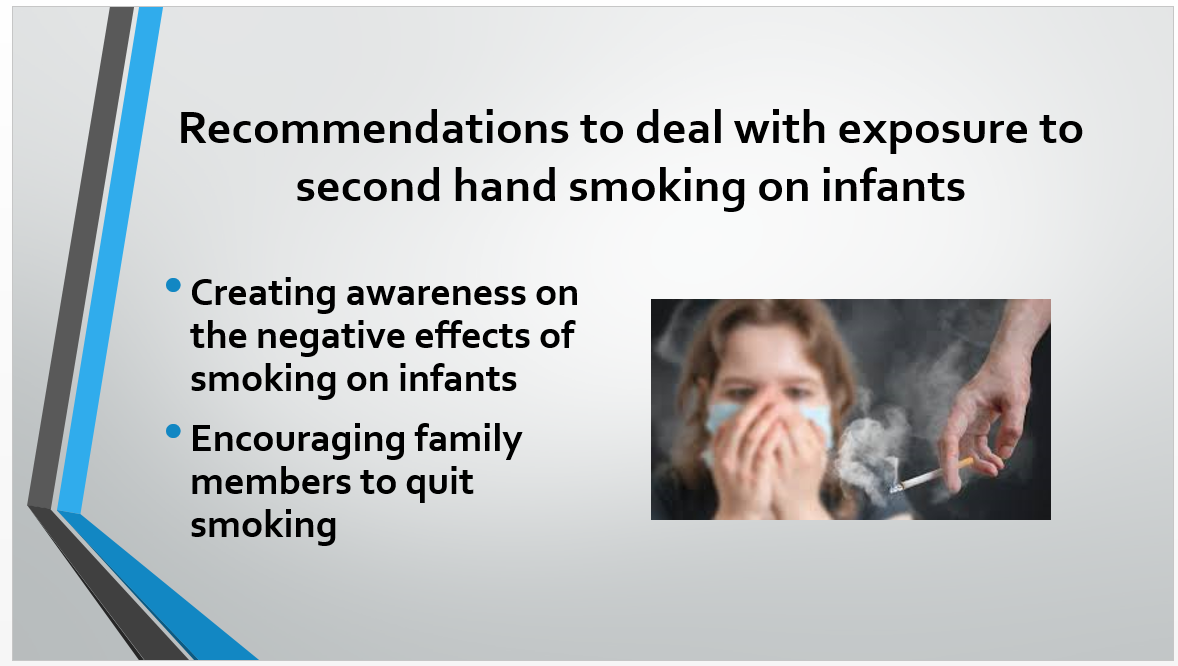
The community also needs to be informed on the negative effects of primary and second hand smoking especially pregnant women. This will make them aware on the dangers of smoking on the health status of infants.
Family members who smoke should also be encouraged to quit smoking
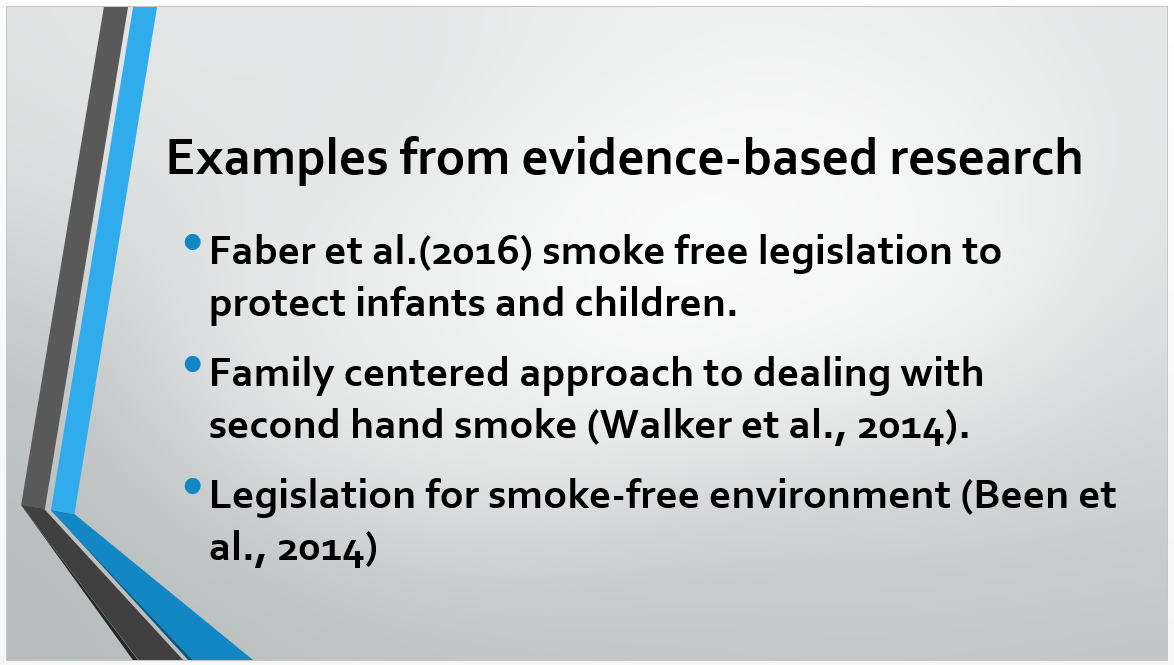
There are various evidence based suggestions and interventions which were given to assist in dealing with exposure of second hand smoking by infants. Some of which include;
Faber et al.(2016) suggested a “smoke free” policy framework which will assist in protecting children from second hand smoke.
Walker et al. (2014), proposes a family centered approach to dealing with secondhand smoking. The authors propose that parents should be encouraged to quit smokin preconception, during pregnancy and after delivery of the child to protect the infant from harmful effects of secondhand smoke.
Been et al. (2014) also suggests implementation of WHO recommendations that petitions for legislation that will create a smoke free environment

In order to protect infants from second hand smoking the main resources to be used should be geared towards dissuading smokers from engaging in the habit. Therefore to assist in doing so, the following are two of the community resources available for residents living in Texas.
I. Adderall Rehab Center Terrell Hills
Adderall rehab center, located in Terrell Hills, Texas, provides a wide range of treatment options for people suffering from drug and substance abuse. The facility has flexible treatment options varying with the intensity of problem being faced by the patient. the center also accepts various cover plans making it affordable for its clientele. The following phone number can be used to contact the facility 1(800) 410-803
II. Right Step Hill Country
Right Step Hill Country in in Wimberley, Texas is another residential rehabilitation facility located in a 30 acre piece of land. The facility offers a wide array of therapeutic services for patients dealing with drug and substance addiction and may be a good option for those aiming to quit smoking as part of the strategies of saving not only themselves, but also their infants. To contact the facility, one can access their website at https://www.rightstep.com/ and through phone calls at 844-675-3958.
for both facilities, the phone numbers can be contacted at any time of the day.
For parents who are determined to protect their children from second hand smoke and have an issue quitting smoking, then the two resources will be of great benefit to them.

National Institute on Drug Abuse (NIDA): Is a national program aimed a dealing with different issues associated with drug abuse including smoking. The institute carries out research and provides relevant information to the public on matter pertaining to drug and substance abuse. The information provided can be of great help in creating awareness and in turn insulating infants from being exposed to second hand smoke from those around them.

smokefree.gov is a government run online based application which offers support to people who are intent to quit smoking. The online platform can assist those who want to quit smoking come up with a plan on how to quit and different therapies to assist in the process.
References
Adams, S. M., Ward, C. E., & Garcia, K. L. (2015). Sudden infant death syndrome. American family physician, 91(11).
Banderali, G., Martelli, A., Landi, M., Moretti, F., Betti, F., Radaelli, G., … & Verduci, E. (2015). Short and long term health effects of parental tobacco smoking during pregnancy and lactation: a descriptive review. Journal of translational medicine, 13(1), 327.
Been, J. V., Nurmatov, U. B., Cox, B., Nawrot, T. S., Van Schayck, C. P., & Sheikh, A. (2014). Effect of smoke-free legislation on perinatal and child health: a systematic review and meta-analysis. The Lancet, 383(9928), 1549-1560.
Faber, T., Been, J. V., Reiss, I. K., Mackenbach, J. P., & Sheikh, A. (2016). Smoke-free legislation and child health. NPJ primary care respiratory medicine, 26, 16067.
Fertman, C. I., & Allensworth, D. D. (Eds.). (2016). Health promotion programs: from theory to practice. John Wiley & Sons.
Fleming, P. J., Blair, P. S., & Pease, A. (2015). Sudden unexpected death in infancy: aetiology, pathophysiology, epidemiology and prevention in 2015. Archives of disease in childhood, 100(10), 984-988.
Wang, Z., May, S. M., Charoenlap, S., Pyle, R., Ott, N. L., Mohammed, K., & Joshi, A. Y. (2015). Effects of secondhand smoke exposure on asthma morbidity and health care utilization in children: a systematic review and meta-analysis. Annals of Allergy, Asthma & Immunology, 115(5), 396-401.
Walker, N., Johnston, V., Glover, M., Bullen, C., Trenholme, A., Chang, A., … & Hawthorne, E. (2014). Effect of a family-centered, secondhand smoke intervention to reduce respiratory illness in indigenous infants in Australia and New Zealand: a randomized controlled trial. Nicotine & Tobacco Research, 17(1), 48-57.
Place your order now for a similar assignment and get fast, cheap and best quality work written by our expert level assignment writers. Use Coupon Code: NEW30 to Get 30% OFF Your First Order
Use Coupon Code: NEW30 to Get 30% OFF Your First Order
Environmental Factors Affecting Infant Development: A Comprehensive Guide for Parents and Healthcare Professionals
Last Updated: July 2025 | Medically Reviewed by Ethan Green, MSN-FNP
The growth, development, and learned behaviors that occur during the first year of infancy have a direct effect on the individual throughout a lifetime. Understanding environmental factors affecting infant development is crucial for parents, caregivers, and healthcare professionals committed to ensuring optimal child health outcomes.
Understanding Environmental Impact on Infant Development {#understanding}
Environmental factors affecting infant development encompass all external conditions and influences that can impact a child’s physical, cognitive, and emotional growth during the critical first year of life. Research consistently demonstrates that early environmental exposures can have lasting effects on neurological development, immune system function, and overall health trajectories.
The Critical First Year Window
During the first 12 months of life, infants experience:
- Rapid brain development: 80% of brain growth occurs in the first year
- Immune system maturation: Critical development of disease resistance
- Sensory system refinement: Vision, hearing, and motor skills establishment
- Cognitive foundation building: Language acquisition and learning patterns
Major Environmental Risk Factors {#risk-factors}
1. Air Quality and Pollution
Indoor Air Pollution represents one of the most significant environmental threats to infant health and safety. Poor indoor air quality can lead to respiratory issues, developmental delays, and increased susceptibility to infections.
Common Indoor Air Contaminants:
- Volatile Organic Compounds (VOCs) from paints, furniture, and cleaning products
- Particulate matter from cooking, smoking, and outdoor pollution infiltration
- Biological contaminants including mold, dust mites, and pet dander
- Carbon monoxide from faulty heating systems or appliances
2. Chemical Exposures
Toxic exposure infants face can come from multiple sources in the home environment:
| Chemical Category | Common Sources | Potential Health Effects |
|---|---|---|
| Lead | Old paint, pipes, soil | Neurological damage, developmental delays |
| Mercury | Fish consumption, broken thermometers | Brain development issues, motor skill problems |
| Pesticides | Household sprays, treated foods | Endocrine disruption, behavioral issues |
| Phthalates | Plastic toys, personal care products | Hormonal interference, respiratory problems |
| BPA | Plastic bottles, food containers | Developmental and behavioral concerns |
3. Noise Pollution
Excessive noise exposure during infancy can impact:
- Sleep patterns and quality
- Stress hormone levels
- Auditory development
- Cognitive processing abilities
Statistical Overview of Environmental Threats {#statistics}
Recent epidemiological studies reveal concerning trends in environmental health impacts on infants:
Key Statistics:
| Environmental Factor | Affected Population | Health Impact |
|---|---|---|
| Air pollution exposure | 93% of children worldwide | Increased respiratory infections (40% higher risk) |
| Lead exposure | 1 in 40 US children | IQ reduction of 3-5 points per 10 μg/dL blood level |
| Secondhand smoke | 25% of infants globally | 70% increased SIDS risk |
| Chemical exposures | 99% of pregnant women | Detectable levels of multiple toxins |
| Noise pollution (>55dB) | 60% of urban infants | 15% increased stress response |
Developmental Impact Timeline:
0-3 Months: Critical period for respiratory system development
- Environmental toxins can establish long-term breathing pattern disruptions
- Air quality directly correlates with sleep quality and growth rates
4-6 Months: Immune system programming phase
- Chemical exposures can alter immune responses for life
- Clean environments support healthy microbiome development
7-12 Months: Motor and cognitive skill emergence
- Lead exposure during this period shows strongest correlation with developmental delays
- Environmental enrichment significantly impacts neural pathway formation
Prevention and Safety Strategies {#prevention}
Creating a Safe Indoor Environment
Air Quality Management:
- Install HEPA air purifiers in nursery and main living areas
- Maintain humidity levels between 30-50% to prevent mold growth
- Use low-VOC or VOC-free paints, furniture, and building materials
- Ensure proper ventilation in all rooms, especially kitchen and bathroom
- Regular HVAC maintenance including filter changes every 3 months
Chemical Safety Protocols:
- Choose organic, non-toxic cleaning products
- Store all chemicals in locked cabinets away from infant areas
- Test home for lead, especially in houses built before 1978
- Use glass or stainless steel feeding bottles and food containers
- Select toys meeting CPSIA safety standards and phthalate-free materials
Nutritional Environmental Factors
Breastfeeding Environmental Considerations:
- Maternal diet impacts milk composition and infant development
- Avoid high-mercury fish during breastfeeding
- Maintain adequate vitamin D levels through safe sun exposure
- Consider water filtration systems to reduce contaminant exposure
Formula Feeding Safety:
- Use filtered or bottled water for formula preparation
- Avoid heating bottles in microwaves (uneven heating, plastic degradation)
- Choose BPA-free, phthalate-free feeding equipment
Creating Safe Environments {#safe-environments}
Room-by-Room Safety Assessment
Nursery Optimization:
- Position crib away from windows to minimize outdoor pollution exposure
- Use organic, certified mattresses and bedding
- Maintain consistent temperature (68-70°F) and humidity levels
- Install blackout curtains to reduce light pollution affecting sleep
Kitchen and Feeding Areas:
- Store infant feeding supplies in dedicated, clean cabinets
- Use separate cutting boards for infant food preparation
- Install carbon monoxide detectors near gas appliances
- Maintain refrigerator temperatures below 40°F
Living Spaces:
- Regular vacuuming with HEPA filters to reduce allergens
- Choose hardwood or tile flooring over carpeting when possible
- Minimize use of air fresheners and scented products
- Ensure adequate natural light exposure during daytime hours
Outdoor Environment Considerations
Air Quality Monitoring:
- Check daily AQI (Air Quality Index) before outdoor activities
- Limit outdoor time when AQI exceeds 100
- Use covered strollers during high-pollution periods
- Create indoor play alternatives for poor air quality days
Safe Outdoor Spaces:
- Choose parks and playgrounds away from heavy traffic
- Avoid areas with visible mold, standing water, or chemical treatments
- Ensure playground equipment meets current safety standards
- Provide adequate sun protection without vitamin D deficiency
When to Seek Professional Help {#professional-help}
Warning Signs Requiring Medical Attention:
Respiratory Symptoms:
- Persistent coughing or wheezing
- Difficulty breathing or rapid breathing
- Unusual chest retractions during breathing
- Recurring respiratory infections
Developmental Concerns:
- Delays in reaching developmental milestones
- Regression in previously acquired skills
- Unusual behavioral patterns or irritability
- Sleep disturbances beyond normal infant patterns
Physical Symptoms:
- Unexplained rashes or skin irritation
- Frequent gastrointestinal issues
- Poor weight gain or feeding difficulties
- Excessive crying or fussiness
Healthcare Provider Consultation Checklist:
When discussing environmental concerns with your pediatrician:
- Document exposure history including home age, renovation activities, and chemical use
- Track symptom patterns related to location and timing
- Bring lists of products used in infant care and home maintenance
- Request environmental health screening if multiple symptoms present
- Discuss family history of environmental sensitivities or allergies
Evidence-Based Recommendations
Professional Guidelines Integration:
American Academy of Pediatrics (AAP) Recommendations:
- Avoid exposure to secondhand smoke completely
- Use EPA-approved water filtration systems
- Choose organic foods when possible for infant nutrition
- Maintain smoke-free, chemical-free home environments
Environmental Protection Agency (EPA) Standards:
- Regular radon testing in homes (especially basements)
- Lead testing for homes built before 1978
- Asbestos inspection before renovation activities
- Proper disposal of household chemicals and medications
World Health Organization (WHO) Guidelines:
- Indoor air quality standards for particulate matter
- Chemical exposure limits for vulnerable populations
- Noise level recommendations for infant sleeping areas
- Water quality standards for infant consumption
Long-term Health Implications
Research demonstrates that environmental factors affecting infant development have consequences extending far beyond the first year of life:
Developmental Trajectory Impact:
- Cognitive Development: Early chemical exposures linked to reduced IQ and learning difficulties
- Behavioral Health: Environmental toxins associated with increased ADHD and autism spectrum disorders
- Physical Health: Early exposures correlate with higher rates of asthma, allergies, and autoimmune conditions
- Social Development: Clean, safe environments support better social skill development and emotional regulation
Epigenetic Considerations:
Environmental exposures during infancy can trigger epigenetic changes affecting:
- Gene expression patterns
- Immune system programming
- Stress response systems
- Metabolic function regulation
Conclusion
Understanding and addressing environmental factors affecting infant development represents a critical investment in lifelong health outcomes. The evidence overwhelmingly supports the importance of creating clean, safe, and nurturing environments during the crucial first year of life.
Parents and caregivers who prioritize environmental health create foundations for optimal development, reduced disease risk, and enhanced quality of life. By implementing evidence-based prevention strategies and maintaining awareness of potential environmental threats, we can significantly improve infant health outcomes and support healthy development trajectories.
The responsibility for environmental health protection extends beyond individual families to communities, healthcare systems, and policy makers. Through coordinated efforts and continued research, we can create safer environments for all infants and children.
References and Expert Resources
Primary Sources and Guidelines:
American Academy of Pediatrics (AAP):
- Policy Statement on Environmental Health: https://pediatrics.aappublications.org/content/pediatrics/early/2019/04/22/peds.2019-0441.full.pdf
- Guidelines for Infant Environmental Safety: https://www.healthychildren.org/English/safety-prevention/all-around/Pages/Environmental-Hazards.aspx
Environmental Protection Agency (EPA):
- Indoor Air Quality Guidelines: https://www.epa.gov/indoor-air-quality-iaq
- Lead Safety Standards: https://www.epa.gov/lead/protect-your-family-sources-lead
- Children’s Environmental Health: https://www.epa.gov/children
World Health Organization (WHO):
- Environmental Health for Children: https://www.who.int/teams/environment-climate-change-and-health/children-and-health
- Air Pollution and Child Health: https://www.who.int/publications/i/item/air-pollution-and-child-health
Centers for Disease Control and Prevention (CDC):
- Environmental Health and Infant Safety: https://www.cdc.gov/nceh/ehhe/
- Lead Exposure Prevention: https://www.cdc.gov/nceh/lead/prevention/default.htm
- Childhood Lead Poisoning Data: https://www.cdc.gov/nceh/lead/data/national.htm
Research Studies and Clinical Evidence:
Peer-Reviewed Research:
- Grandjean, P., & Landrigan, P. J. (2014). Neurobehavioural effects of developmental toxicity. The Lancet Neurology, 13(3), 330-338. https://doi.org/10.1016/S1474-4422(13)70278-3
- Braun, J. M. (2017). Early-life exposure to EDCs: role in childhood obesity and neurodevelopment. Nature Reviews Endocrinology, 13(3), 161-173. https://doi.org/10.1038/nrendo.2016.186
- Rauh, V., et al. (2015). Brain anomalies in children exposed prenatally to a common organophosphate pesticide. PNAS, 109(20), 7871-7876. https://doi.org/10.1073/pnas.1203396109
Environmental Health Research:
- National Institute of Environmental Health Sciences (NIEHS): https://www.niehs.nih.gov/health/topics/population/children/
- Children’s Environmental Health Centers: https://www.niehs.nih.gov/research/supported/centers/prevention/
- Environmental Health Perspectives Journal: https://ehp.niehs.nih.gov/
Professional Medical Organizations:
Pediatric Environmental Health Specialty Units (PEHSUs):
- National PEHSU Network: https://www.pehsu.net/
- Regional PEHSU Contact Information: https://www.pehsu.net/findhelp.html
American College of Obstetricians and Gynecologists:
- Environmental Health Guidelines: https://www.acog.org/clinical/clinical-guidance/committee-opinion/articles/2013/10/exposure-to-toxic-environmental-agents
International Society for Environmental Epidemiology:
- Research Database: https://www.iseepi.org/
- Environmental Health Policy Statements: https://www.iseepi.org/about/policy-statements
Government Health Resources:
National Institutes of Health (NIH):
- Eunice Kennedy Shriver National Institute of Child Health and Human Development: https://www.nichd.nih.gov/health/topics/environmental
- Environmental Health Information: https://www.nlm.nih.gov/medlineplus/environmentalhealth.html
Food and Drug Administration (FDA):
- Chemical Safety for Infants: https://www.fda.gov/consumers/consumer-updates/bpa-what-you-should-know
- Infant Formula Safety: https://www.fda.gov/food/people-risk-foodborne-illness/infant-formula-safety
International Health Organizations:
United Nations Environment Programme (UNEP):
- Children and Environmental Health: https://www.unep.org/topics/chemicals-and-pollution/pollution-and-health/children-and-pollution
- Global Chemicals Outlook: https://www.unep.org/explore-topics/chemicals-waste/what-we-do/policy-and-governance/global-chemicals-outlook
European Environment Agency:
- Children’s Environmental Health: https://www.eea.europa.eu/themes/human/children-health
- Air Quality Standards: https://www.eea.europa.eu/themes/air/air-quality-concentrations
Data Sources and Statistics:
Global Health Observatory (WHO):
- Environmental Risk Factors: https://www.who.int/data/gho/data/themes/environmental-health
- Child Mortality and Environmental Factors: https://www.who.int/news-room/fact-sheets/detail/children-environmental-health
Environmental Working Group:
- Chemical Safety Database: https://www.ewg.org/areas-focus/childrens-health
- Consumer Product Safety: https://www.ewg.org/consumer-guides

